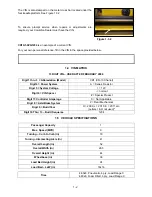
Your safety and the safety of others depend on your safe operation and maintenance of this vehicle. Prior
to operation, you, the operator, must be thoroughly familiar with this and all other sections of this manual.
2.3 SAFETY WARNINGS
For personal safety and to maintain stability and control, operate this vehicle under these
conditions only. Failure to comply with these warnings may result in bodily injury and property
damage.
Do not drive this vehicle unless you are a qualified and trained operator and familiar with
the vehicle operational controls.
Never exceed the capacity ratings of the vehicle. Exceeding these limits may endanger
occupant or cause vehicle damage.
Completely stop vehicle before stepping off.
If vehicle is to be left unattended, turn keyswitch to “OFF” and remove key.
Do not use accelerator to hold vehicle on an incline. Use brake.
Do not change the directional keyswitch while vehicle is moving.
Drive slowly in turns and up and down grades. Do not make turns on steep hills or inclines.
Do not operate while under the influence of alcohol or drugs.
To avoid the risk of injury or vehicle damage, operate at maximum speed only on smooth
flat surfaces.
Allow additional stopping distance when traveling at higher speeds.
Do not drive this vehicle in hazardous areas unless this vehicle is approved and labeled for
such operation.
Keep a safe distance when following other vehicles and from the edge of ramps and
platforms.
Immediately report any accident or vehicle problem to your supervisor.
2.4 SAFETY CONCERNS
It is recommended that the operator and owner or renter of this vehicle comply with the OSHA
requirements as stated in the Code of Federal Regulations, Section 29, 1910.178, Powered Industrial
Truck Training Standard and the ANSI requirements as stated in Personnel and Burden Carriers ANSI
B56.8.
As a minimum every operator should, in addition to the above requirements found in the standards noted
above:
Demonstrate a working knowledge of each control.
Understand all safety rules and guidelines as presented in this manual.
Know how to properly load and unload cargo.
Know how to properly park the vehicle.
Recognize an improperly maintained vehicle.
Demonstrate ability to handle the vehicle in all conditions.
Every owner or renter of this vehicle must, at a minimum:
Define where the vehicles should and should not be driven and utilized.
Ensure all proper warnings as to driving hazards are properly displayed and visible.
Install safety signage concerning hills, speed bumps, ramps, turns, blind crossings, intersections,
etc.
Define who should and who should not drive the vehicles.
Enforce safe driving and operating rules.
Provide driver training for first time operators and review safe operating recommendations regularly.
Maintain vehicles in a safe operating condition and maintain a schedule for daily, weekly, monthly,
quarterly, semi-annually and annual vehicle inspections.
Determine who, when, and how should pre-operation inspections be conducted.
Notify operators what should be done if an unsafe condition or operating problem is discovered.
2-2
























